How Do You Hide a Projector Screen?
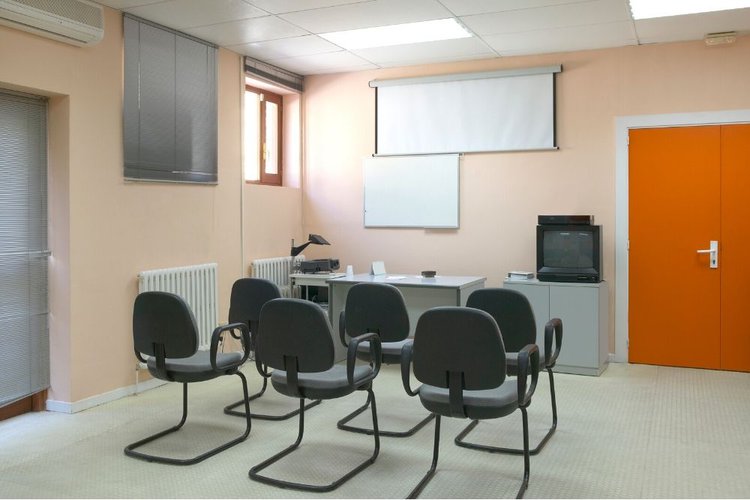
Most people buy a projector so that they can experience larger-than-life visuals from the comfort of their homes – something that even the largest flat-screen television cannot afford (at least not currently).
Many opt for a projector also because they could easily stow away the device and hide the screen out of sight so that the projector and the screen do not mar a space’s design or ambiance – as those black, flat-screen television slabs do.
But not every projector user knows how to neatly tuck away those thin projector screens away when not in use. If you are one of them, keep reading.
Quick Navigation
Why Hide a Projector Screen?
If given a choice, most people would want to make their projector screens discreet. And there are solid reasons for that.
To Achieve a Cleaner Look
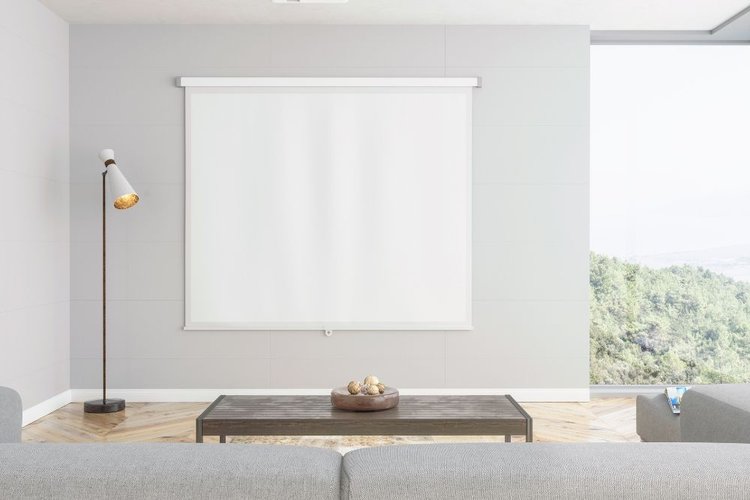
As alluded to above, projector screens don’t blend in with the overall design language of a modern space. They fare poorer than televisions.
Smart TVs and the audio gear and other paraphernalia that tag along have become so ubiquitous; it’s no longer too awkward to see a black slab in the middle of a room. Professional interior designers draw out their designs knowing they’ll have to carve out wall space for a TV.
Projectors and their screens, on the other hand, aren’t as popular or haven’t proliferated enough to become as homogeneous, yet.
When fully wielded, a projector screen pretty much sticks out like a sore thumb. Even a white screen with a white background won’t look good because the screen juts out or doesn’t become one with the wall.
From the sides, the incongruence is even more glaring.
To Make Way for the TV
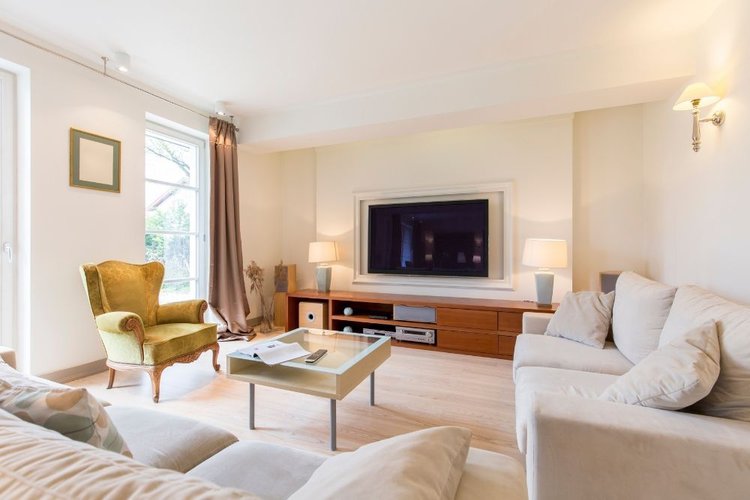
Even in rooms or spaces dedicated to media consumption and entertainment, a projector screen that retracts back and hides completely is a lot more aesthetically pleasing than the stationary ones.
With a screen that can move out of the way, it becomes easier to use a television or switch between the two whenever the need arises. Most people with a dedicated entertainment room usually have a television in tow and do not entirely depend on a projector for all their video entertainment requirements.
To Let Air and Light Pass
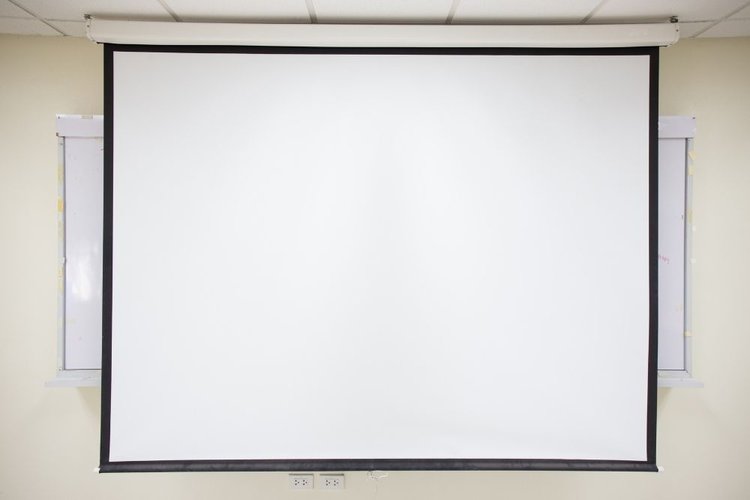
In most homes, a projector screen could be pulled out right before a window. In educational institutions and business meeting rooms, projector screens are pulled down in front of a whiteboard.
Since a projector screen gets positioned before a whiteboard or a window, it must move out of the way when not used.
Two Common Types of Projector Screens
Before trying to hide a projector screen, get to know the kind of screens available so you know what you’re working with.
Projector screens can be very broadly categorized as:
Tripod Screens
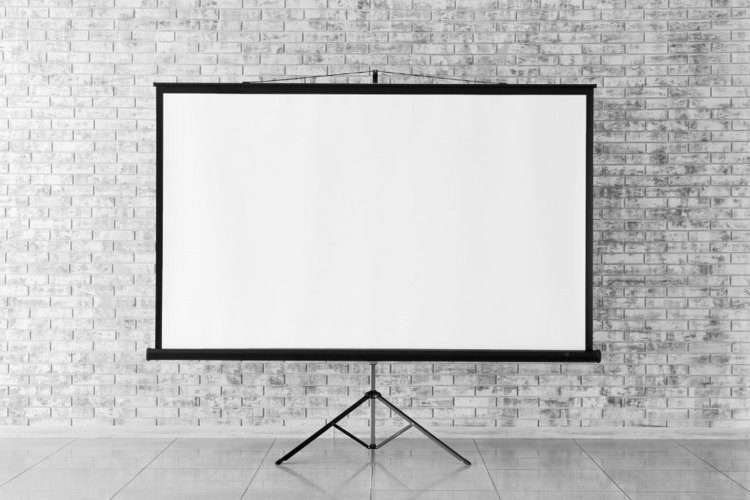
The stand-based projector can be rolled up, carried around, and hidden out of sight. It’s a type of projector screen that you won’t need expert advice to hide efficiently and effectively.
Also, some of them are rigid or fixed and cannot be pulled down or up. In such cases, you’ll have to move them in their original form.
Retractable Screens

Retractable projector screens can retract and descend manually or automatically.
A manually operated screen can be pulled down and pushed into its housing by hand. The motorized version pulls itself down and up automatically on a button press on its remote control.
A manually retractable screen would look odd, inelegant in a room already decked up with different gadgets and other advanced tech. Even if the space is light on equipment and relatively plain, it’s worth paying the extra money for the automatic functionality.
How to Hide a Retractable Projector Screen?
Before answering the question, ascertain how “hidden” you want the projector screen to be.
Do you want to hide just the screen or the entire housing? If it’s just the screen, projector screens are already factory-designed to do that. You can simply install the projector housing to your wall or ceiling, set up the electronics, and be done.
But if the goal is to hide the screen and its housing or make the projector screen completely invisible, you’ll have to put in some thought, time, and effort.
The Ceiling Types You Can Work With
Since retractable screens have their base located in the ceiling, ensure the upper surface is ideal for the job. Here are a couple of ceiling types that you’ll usually end up working with:
Coffered Ceiling
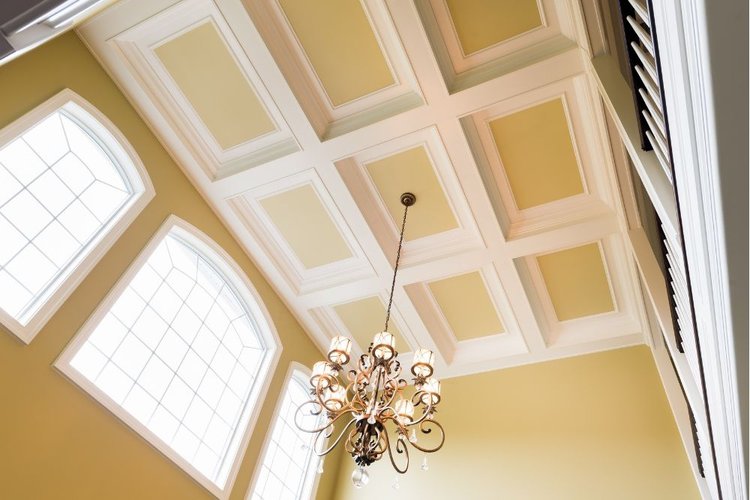
A coffered ceiling consists of multiple square-like, octagonal, or rectangular grids in recessed or three-dimension sunken panels.
These ceilings work as great camouflages. The housing of your projector screen can easily be nestled in one of the geometric blocks. Besides, the ceiling can also conceal specific architectural quirks the upper surface of your house may have, such as non-removable beams or exposed pipes.
If you choose to give the entire ceiling the “coffered” treatment, use one of the blocks to conceal your projector with a motorized lift.
The best part about a coffered ceiling is you need not build it from scratch or bring down your existing ceiling. It can be worked into your current ceiling since it’s basically attaching blocks or physical elements.
The design works admirably in rooms with relatively high ceilings. The setup, however, won’t be suitable in physical confines that don’t offer much vertical leeway or the ceiling is too low.
Flush Ceiling
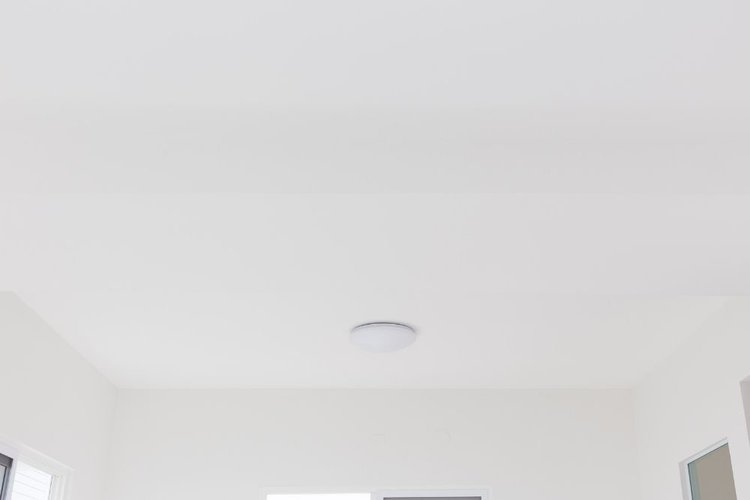
A flush ceiling is flat or has no indentations or protrusions. It’s non-ornate and won’t grab attention per se.
If the ceiling in your space is low and/or you don’t fancy the “baroqueness” of a coffered ceiling, a flush ceiling is ideal.
Make sure the screen’s housing is the same color as your ceiling. Being able to level the screen with the deck is only half the job done. If the colors do not match, the setup won’t look seamless.
However, if you want the projector screen discernible when completely set in place, go ahead and play with the hues. You could opt for the screen housing’s color to either complement your ceiling’s color or be strikingly contrasty.
How Do You Install a Recessed Projector Screen?
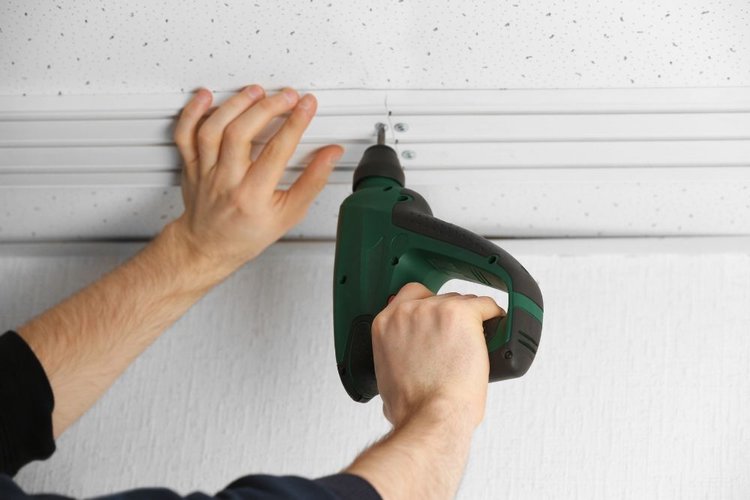
An in-ceiling or recessed projector screen is usually best installed by professionals, especially to get the wiring part right.
If you have never played handyperson in the house before, watching a few YouTube videos or reading multiple how-to articles won’t cut it. You could damage the ceiling and, even worse, hurt yourself.
But if, on the other hand, you’ve used hammers, hand tools, tape measures, levels, etc., to good effect before, following the instructions below won’t be that tricky. Just make sure you have help on standby.
You’ll need the following items for the job:
- Mounting brackets
- Threaded rods
- Adjustment hex tools
- Infrared sensor wiring
- Cutting blade (keyhole saw , for example)
The items usually come bundled in with the projector.
Once you have your tools handy, follow these steps:
P.S. The instructions below apply to both coffered and flush ceilings.
- Ascertain where you exactly want to position the screen in the ceiling.
- Measure the projector screen and also the plastic coverings.
- Use the measurement to mark the area in the ceiling. Make sure the area measured is not too close to the wall (at least five to six inches away).
- Double-check your measurements before proceeding to cut the ceiling portion out.
- Use the cutting tool to cut out the marked portion. Pay attention to the holes you drill. You don’t want them to be too big or narrow. They must be identical to the holes on the brackets.
- Attach the mounting brackets to the projector screen using nuts and bolts. Tighten them up using a wrench.
- Elevate the screen housing and set it in place with the brackets playing anchors.
- Once done, place the plastic covers to provide the finishing touches.
If installing the projector screen in your attic, use the threaded rods to hold the screen’s housing at both ends from the top, as the lower deck may not be strong enough to hold the screen in place. The threaded rods will share the load with the mounts or offer some much-needed rigidity.
To learn how the electronics are put into place or how the IR sensors work for the projector screen to descend and go back in automatically, watch this video: (The video also demonstrates the installation process.)
How to Hide a Fixed Projector Screen?
If your projector screen is not descending from the ceiling, the above methods obviously will not help hide it.
Unlike setting up the base for a retractable screen, there’s no real mechanism in place to hide a fixed projector screen. The screen stays put, and you’ll have to come up with innovative ideas to hide it or make it less noticeable in a room.
This limitation of fixed screens is why people are usually willing to put up with the trouble and time needed to set up a retracting screen into their ceilings.
Others who don’t mind their projector screens being out in the open for everyone to see are the ones who opt for a fixed projector screen.
But if you are among those rare breeds who like a fixed projector screen and want the ability to hide the screen, you, unfortunately, don’t have many options.
Some makeshift techniques may come to your rescue.
Ways to Hide a Fixed Projector Screen
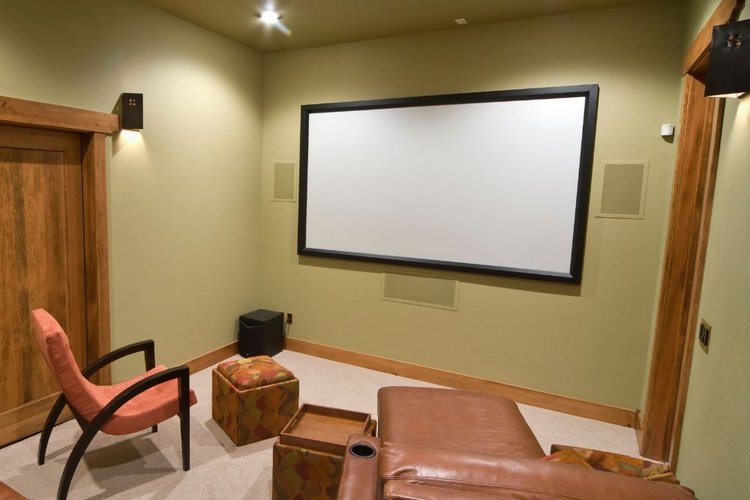
Move or slide a piece of furniture or something similar and place it right before the screen to hide it.
If you don’t have a piece of furniture large enough, you may hang some form of covering (like window blinds) in front and slide it across whenever you’re not using the projector.
Quite clearly, the above methods aren’t the most efficient ways to get the job done – the first one entails some form of effort and is also cumbersome. Not to mention, it requires moving the object each time you want to use the projector.
The sliding screen approach is comparatively less clumsy and not as effort-intensive, but it still isn’t the most elegant way to hide a projector screen. It’s a complex solution to a relatively simple problem.
A more seamless and cleaner method would be placing a picture frame alongside the projector screen’s perimeter and inserting some painting or a family picture within the enclosure for a more artistic and unforced-looking concealment.
Conclusion
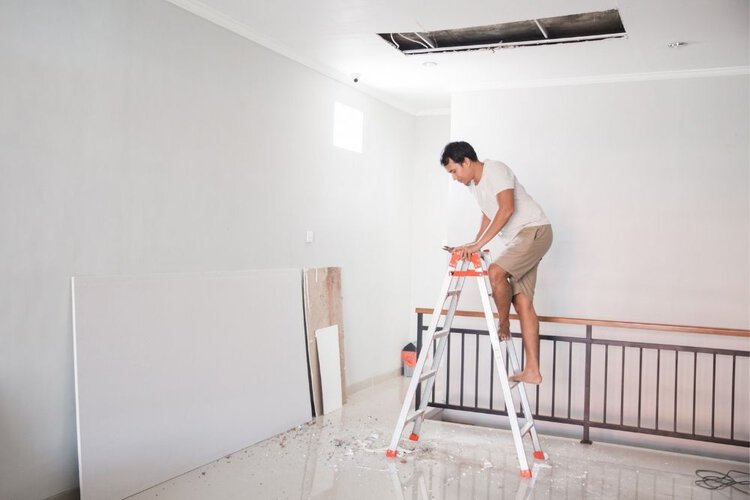
Installing a retracting projector screen is easier said than done. The setup may look pretty straightforward. But the amount of planning and effort needed to pull off the task comes to the fore only once you start working on the job.
And if the objective is to hide the screen when it’s not being used, you’ll have to be a lot more meticulous with the measurements, the tools, the projector screen you pick, and the process in general.
Just to reiterate, hiring a professional is always the best approach to install a recessed projector screen.
But if you cannot afford one, find one, or would like to save money and dive in yourself, this article hopefully provided you all the information you needed to get rolling and complete the project.
Catherine Tramell has been covering technology as a freelance writer for over a decade. She has been writing for Pointer Clicker for over a year, further expanding her expertise as a tech columnist. Catherine likes spending time with her family and friends and her pastimes are reading books and news articles.

